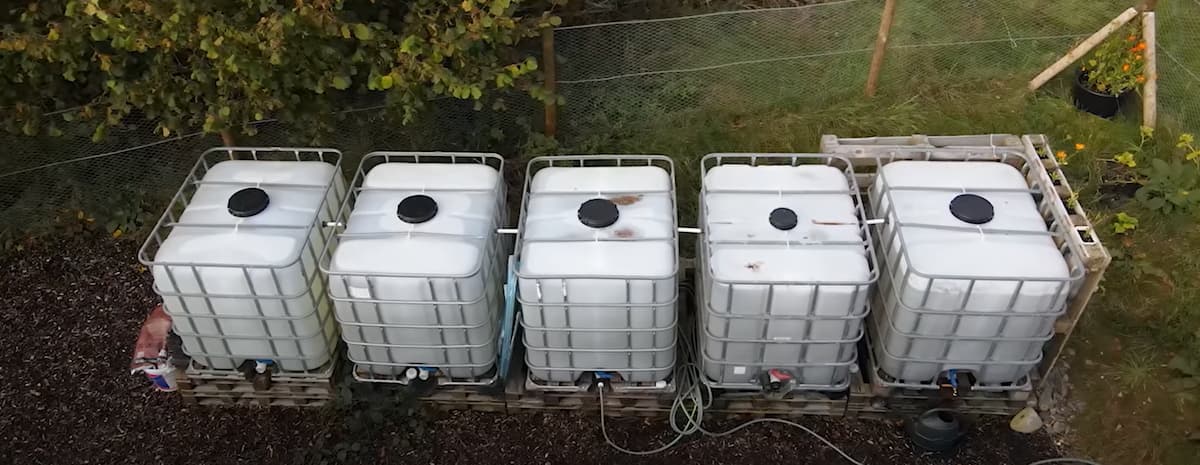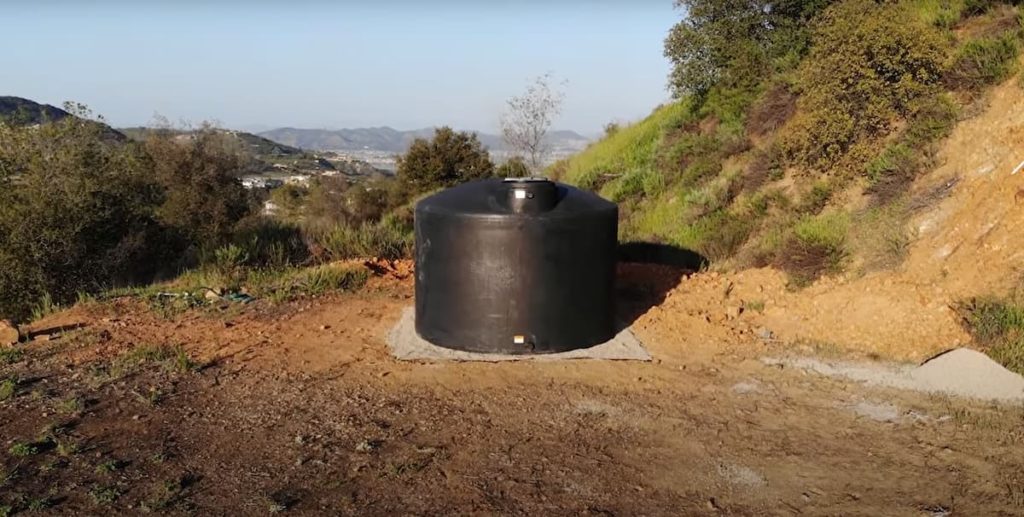
Rainwater is a highly valuable natural resource. Rainwater may be used to help you save money on your water bill, provide an additional supply during water scarcity, and preserve a beautiful, healthy garden. Mains water consumption can be reduced by up to 100 per–cent depending on tank size and weather conditions. This could assist:
- Reduce the need for new dams or desalination facilities.
- In rivers, keep existing environmental flows intact.
- Reduce infrastructure operating expenses.
Rainwater harvesting also helps to avoid local flooding and creeks’ scouring by reducing stormwater runoff.
Common Uses for Rainwater Tanks
Rainwater may be collected and used by individuals inside rainwater tanks in a variety of ways depending on their location. Urban households generally have access to a supplied (mains) water supply. Installing a rainwater harvesting system can considerably reduce mains water usage. Most rural homes rely on the waters of their own property for all of their drinking needs. Rainwater is mostly utilized indoors, whereas river, bore, or dam water is utilized outside.
Rainwater collected from a well-designed, well-maintained system can be used for all domestic purposes. The more uses, the greater the savings in mains water usage. Keep in mind that because drinking and cooking use such a small quantity of water, you could utilize your public reticulated water supply (if available) for drinking and cooking instead of using filtered rainwater since it is fluoridated, disinfected, and generally treated. Consult your state or territorial health department for additional information. Each application demands a unique type of rainwater.
Is Rainwater Tank Drinking Water Safe?
Yes. A well-maintained rainwater tank may provide excellent drinking water. If the rainfall is clear, odourless, and comes from a well-kept water catchment system, it’s probably safe and unlikely to cause illness for most users.
Throughout rural Australia, rainwater tanks are frequently used as a source of drinking water. To protect your and your family’s health, the water used for domestic activities such as drinking, cooking, or bathing could adhere to strict water quality standards. There could be no dangerous germs or hazardous chemicals in the water. Contamination of water with harmful microorganisms such as bacteria and parasites from bird or animal droppings is by far the most significant health hazard. Rainwater tanks can also be tainted by materials on the roof or in the plumbing.
Rainwater collected in domestic tanks may have a lower microbiological quality than that of many public water supplies. Rainwater can occasionally cause illness due to contamination. Providing systems, on the other hand, are adequately maintained, the danger of harmful organisms becoming present is minimal. Premises that provide services to the public or to employees and employ rainwater for drinking and/or cooking must meet the requirements of the NSW Public Health Act 2010, as well as have a quality assurance program according to the NSW Private Water Supply Guidelines.
Collect Rainwater in Urban Areas
The public water supply in cities is still the most dependable source of high-quality drinking water for the neighbourhood. NSW Health endorses rainwater tanks for non-drinking purposes, such as first flush toilet flushing, washing clothes, or utilizing them to heat water, and outside usage for things like garden watering, automobile washing, filling swimming pools, spas and ornamental ponds, and fire fighting in these areas. The usage of rainwater conserves water and reduces stormwater pollution. NSW Health encourages people to use the public water supply for drinking and cooking because it is generally filtered, treated, and fluoridated in urban areas.
When there is a public water supply accessible, see NSW Guideline on Rainwater Usage for more information. Public water supplies are regularly tested for quality. Those who choose to drink and cook with rainwater could be aware of the potential health concerns associated with bacterial and chemical contamination. Rainwater tanks in metropolitan areas can become contaminated with airborne pollutants from heavy traffic, smelters, and heavy industry. Rainwater systems must comply with the local council and water utility standards.
Where to Install Rainwater Tanks
Rainwater tanks may be used to harvest rainwater and store it for later use, but there are a few factors to consider before doing so. There are three methods for installing the tank:
- On the ground
- On a stand
- Party underground tanks
You could select a location for your aquarium that is flat and sturdy enough to support the tank. The next thing to consider is the size of the tank. Not just that there’s adequate space for the tank, but also for all of the pipes you’ll need to link it together. Tanks are available in a variety of shapes and sizes, so you may choose one that fits your home.
Installing Rainwater Tanks
The base underneath your tank is critical. Every litre of water you collect may weigh one kilogram. When full, a 1000-litre tank may weigh 1000 kg, whereas a 10,000-litre tank may weigh more than ten tonnes (10,000 kilograms). A solid material like a concrete slab is recommended underneath the rainwater tank.
When putting in the tank, keep track of where the pipes may enter and exit. The tank may be rotated after it has been installed, but doing it correctly the first time is easier. Connecting the pipes is a crucial operation since it might result in localized flooding in your garden or house if done incorrectly. Hiring a professional plumber to perform this work is a smart idea. Although there is an expense associated with this, it does not significantly increase the cost of your rainwater tank installation.

Increasing Your Drinking Water Supply With Rainwater Tanks
Drinking rainwater is not always smart, it can be used to increase your drinking water supply when the public water supply has been tainted or has run out. For example, during a drought, when levels of local reservoirs are low when there’s an emergency water situation in the region due to contaminated supplies or flooding, you have access to more freshwater. Harvesting rainwater in an aquarium connected with your existing water supply makes this possible since there is usually no need for filtration if tap water is used.
NSW Health recommends only using collected rainwater for non-drinking purposes. If you decide to use it anyway, tank quality assurance programs are mandatory under NSW guidelines. The NSW Department of Health may monitor these types of programs to ensure that monitoring guidelines are met. Make sure you follow all water restrictions for roof draining.
Materials a Rainwater Tank Can Be Made From
A rainwater tank is a large, enclosed container that holds water to be used in toilets or washing machines. The quantity of water stored in tanks depends on the building structure and how much the roof can collect. Domestic tanks may be made from materials such as:
- Plastic (polyethylene)
- Glass-reinforced plastic (GRP)
- Concrete (the most common material used to make tanks)
- Stainless steel (best quality, but can be expensive)
The tank size shouldn’t really matter. These are usually around three metres tall, but larger ones are available for commercial buildings.
Concrete Tanks as Rainwater Tanks
Concrete tanks are the most popular rainwater tank systems due to their affordable prices and sturdiness. They can also be made in mass, so they’re easy to install. The only disadvantage is that a concrete tank requires more maintenance than most other types of water tanks, but this can be avoided with proper care.
Although it’s not required, some people choose to paint their tanks with anti-bacterial paints or coatings. This is meant to inhibit the growth of bacteria that can become airborne and makes their way into your water supply. At some point, you’ll have to clean your tank, so you could think about how you’ll do this before buying a rainwater tank. If you don’t want to get involved in maintaining your aquarium, it may be better to buy a different type of water tank made of another material.
Steel Tanks as Rainwater Tanks
Steel tanks are another popular type of rainwater tank due to their flexibility. They can be made into any size or shape, so you can customize the materials according to your needs. This is very important since moving water around everywhere could damage electrical wires and other items that are generally close together. The only disadvantage is that a steel tank tends to rust over time. Some people choose to coat the inside of their tanks to prevent this since it might affect the purity of the water they hold, but rust is also not good for drinking purposes because it can be harmful to your health if consumed in large quantities.
Moulded Polyethylene Tanks as Rainwater Tanks
Polyethylene tanks are another popular choice since they are generally more affordable than most other types of water tanks. The only disadvantage of these types of tanks is that they’re less flexible. Polyethylene rainwater tanks can be manufactured in various sizes and shapes, but not to the same degree as steel tanks. However, polyethylene tanks are easy to clean and do not rust or break.
Plastic Tanks as Rainwater Tanks
If you don’t want to use concrete or metal, plastic rainwater tanks are another option. These types of tanks are easier to install than concrete alternatives and require less maintenance. With proper care, they can last 20 years or more. They’re also cheaper than other types of alternative water tanks.
The main disadvantage of using a plastic tank is that bacteria tend to accumulate and grow on the walls of these tanks. It’s possible for these bacteria to end up in your drinking water supply, so they’re not recommended if you plan to use the collected rainwater for human consumption.
How to Collect Rainwater?
There are various simple techniques you can use to collect rainwater. The most effective of these is a downspout system consisting of gutters and drop pipes. Other alternatives include barrels, buckets, tanks or cisterns that collect water from the roof by using storage containers such as rain barrels, underground cisterns or large-capacity reservoirs.
Take note of where your property falls in relation to the drainage path for surface runoff. This may help you decide where to place the first part of your downspout system. You can then measure how many rungs you’ll need to connect it with the location where you plan to store your collected rainfall
To make sure all excess water flows out of this tank once it’s full, make sure the outlet is at least one meter from the bottom of the tank. If you don’t, it could overflow and make a mess all-around your home or yard. That’s why it’s also best to put an elbow joint in this section of guttering too, just to be safe.
Gutters as a Rainwater Tank Inlet
If you’re trying to capture rainwater, you could install gutters on your roof since this may take advantage of every last drop that falls down instead of letting it go to waste. It’s also important to clean these gutters regularly so they can work properly without any problems. At some point during the year, there may be areas where water doesn’t flow through your drainage path because it freezes during winter time due to lower temperatures. You’ll want to make sure that your storage tank doesn’t overflow as a result of this.
Remember to always check how much water can be stored by your rainwater harvesting system, as well as the maximum it can hold. This may help you avoid things like overflowing and other problems that could cost you money or time to repair. The capacity of a stainless steel tank is an important consideration when choosing this type of alternative water tank. It’s also vital for all types of tanks to have a reliable overflow mechanism, whether it’s automatic or manual. You don’t want to constantly worry about collecting excess rainfall and having nowhere for it to go
When setting up gutters on your roof, try putting down an elbow joint too. This flexible connector allows the gutter to maintain its shape, while still making it easier for water to flow through. You can choose to install one joint every 2m or so depending on the layout of your drainage path. It’s also possible to get downspouts with built-in elbows if you think they’ll work better for your home. How much rainwater you can collect depends on the tank size and the amount of rain that fell inside the catchment area.





